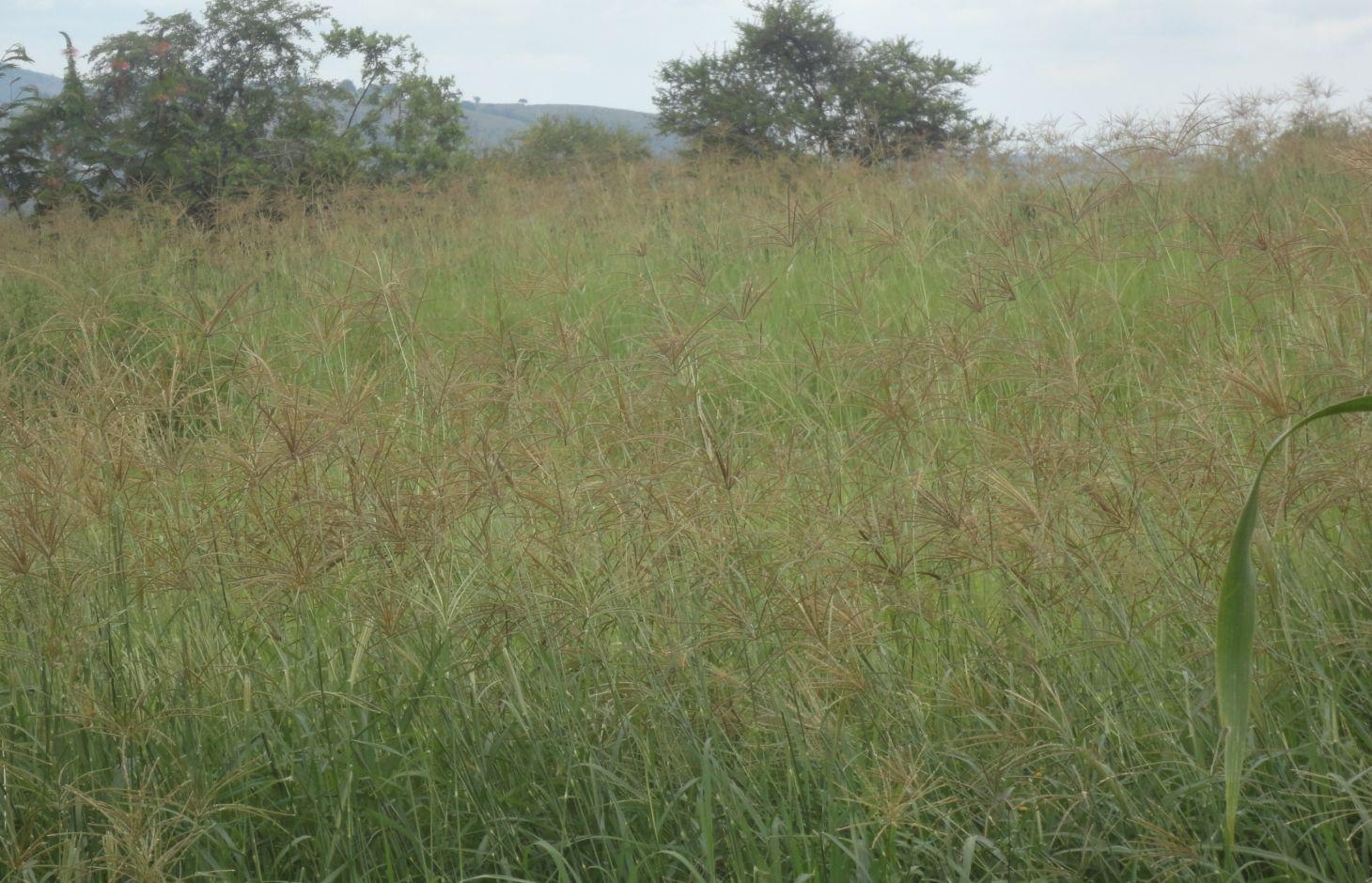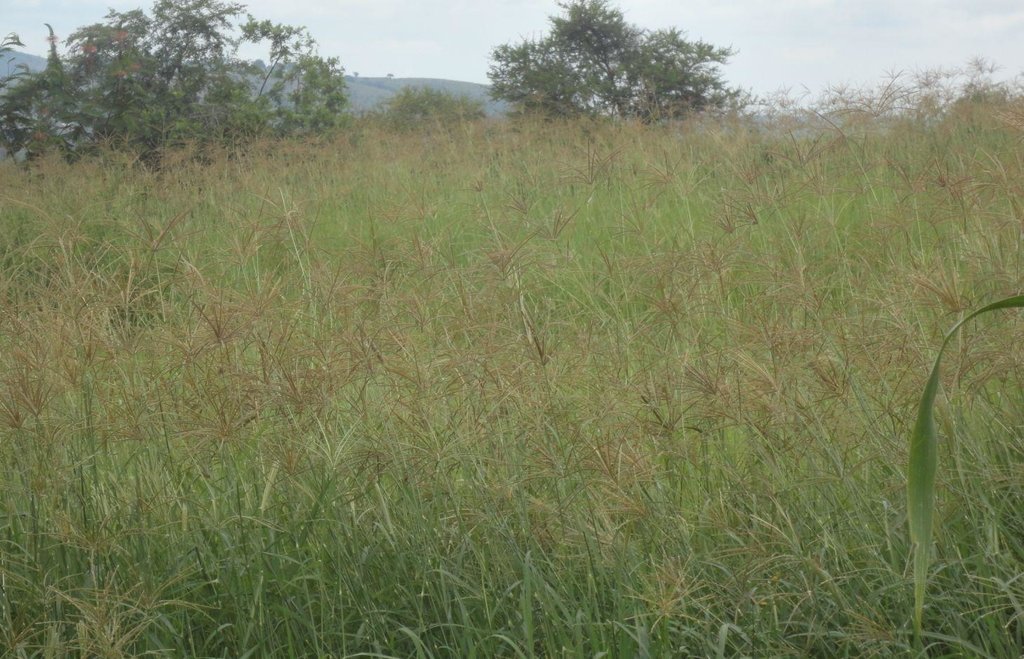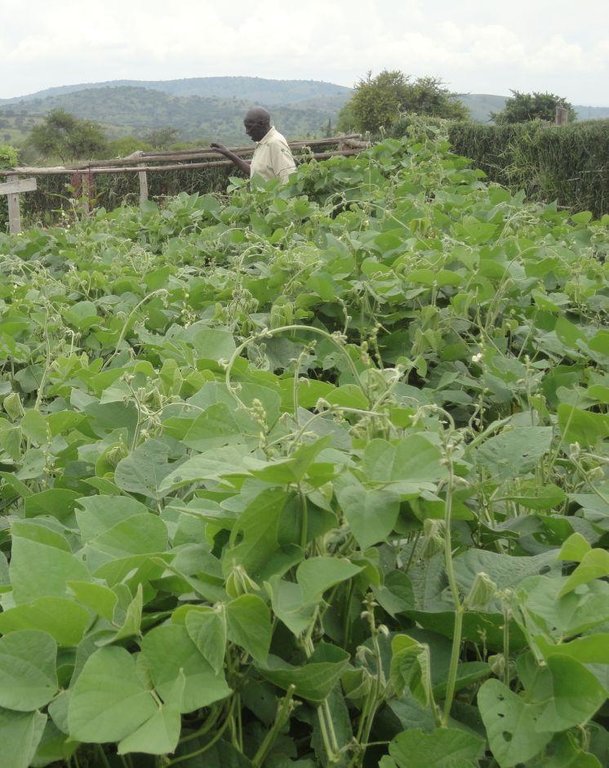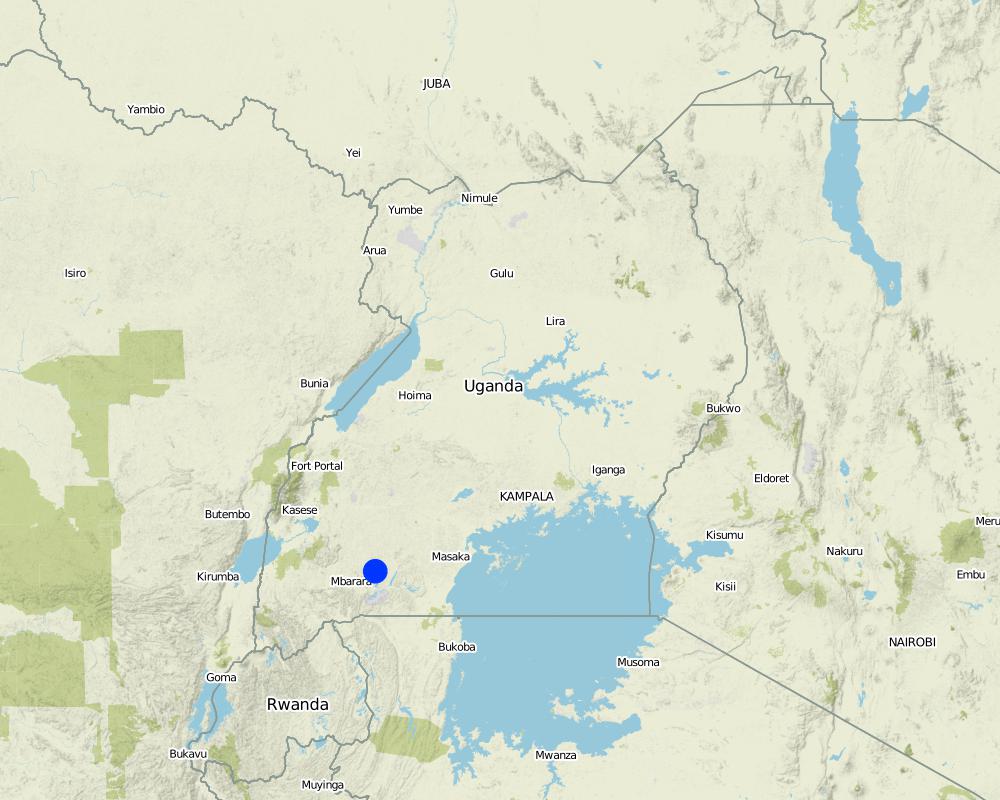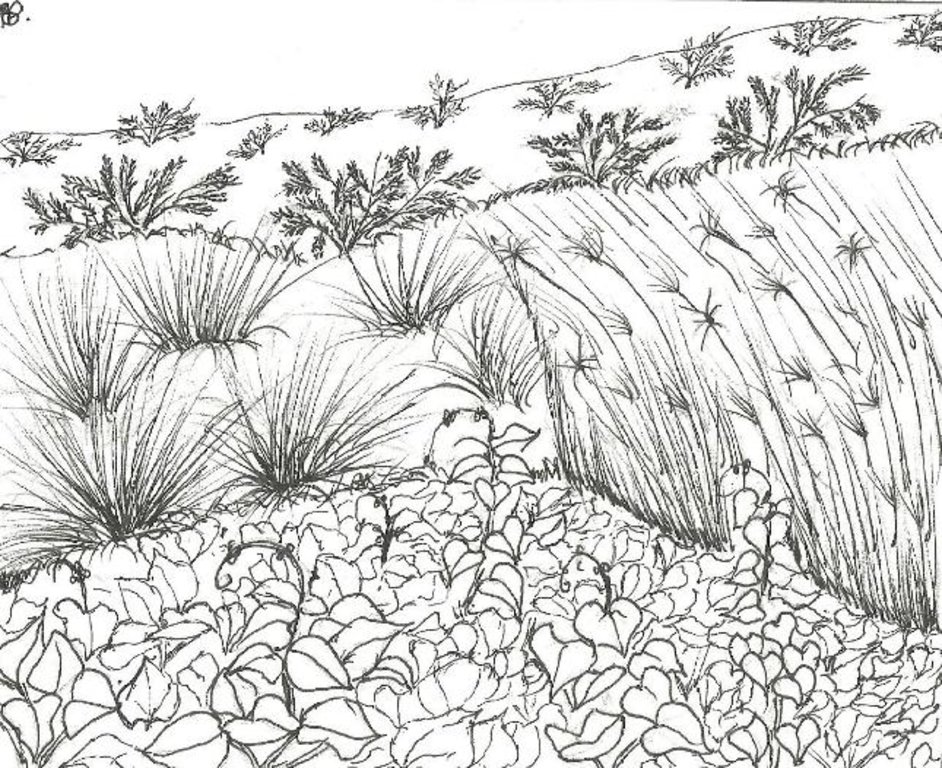Improved fodder production on degraded pastureland [اوغندا]
- تاريخ الإنشاء:
- تحديث:
- جامع المعلومات: Wilson Bamwerinde
- المحرر: –
- المراجعون: Fabian Ottiger, Alexandra Gavilano
Okubyara Obunyatsi (Runyankore)
technologies_1588 - اوغندا
عرض الأقسام
توسيع الكل طي الكل1. معلومات عامة
1.2 تفاصيل الاتصال بالأشخاص الرئيسيين لمصدر المعلومات والمؤسسات المشاركة في تقييم وتوثيق التقنية
متخصص في الإدارة المستدامة للأراضي:
متخصص في الإدارة المستدامة للأراضي:
اسم المشروع الذي سهّل توثيق/تقييم التقنية (إذا كان ذلك على صلة)
The Transboundary Agro-ecosystem Management Project for the Kagera River Basin (GEF-FAO / Kagera TAMP )اسم المؤسسة (المؤسسات) التي سهلت توثيق/تقييم التقنية (إذا كان ذلك على صلة)
Food and Agriculture Organization of the United Nations (FAO) - إيطاليا1.3 الشروط المتعلقة باستخدام البيانات الموثقة من خلال WOCAT
يوافق جامع المعلومات والشخص (لاشخاص) الرئيسي لمصدر المعلومات على الشروط المتعلقة باستخدام البيانات الموثقة من خلال WOCAT:
نعم
2. وصف تقنيةالإدارة المستدامي للأراضي
2.1 وصف مختصر للتقنية
تعريف التقنية:
Transformation of degraded pastureland to high quality fodder plots.
2.2 وصف تفصيلي للتقنية
الوصف:
Grass and legumes are planted on degraded pasture land in fenced fodder plots within the drought prone cattle corridor of Kiruhura district. This climatic zone is characterized by short periods of intense rains followed by long dry spells. Previously, most of the pastoralists of Kiruhura led a nomadic lifestyle, moving their livestock over large areas in search of pasture and water. The combined effects of prolonged droughts and livestock movement over a defined corridor, led to increasing degradation of pastureland, reducing both the quantity and quality of pastures and worsening soil erosion. Therefore the pastoralists have settled down plant pastures instead. Grasses cultivated in the range lands of Kiruhura are Pennisetum purpureum (elephant grass), Stylosanthes guianensis (stylo), Chloris gayana. The legumes are Calliandra spp. and lablab.
Purpose of the Technology: The main objective of the technology is to improve the availability of quality forage and fodder for livestock during the dry season and to feed small ruminants. The other objective is to stop runoff which usually destroys crops, increase water infiltration during the rains and lessen the effect of floods. The benefits of fodder cropping include the protection of soil from erosion by increasing surface cover, improved soil fertility from the legumes, improved livestock production and consequently higher manure production.
Establishment / maintenance activities and inputs: Establishment involves digging, to loosen the soil and remove other grasses that would compete with the planted grasses. Digging is labor intensive and the land owner usually hires labor. The technology requires simple gardening tools such as the hand hoe for digging the soil, and a panga to clear invasive bushes, usually Lantana camara. In addition, irrigation may be necessary in the first 2 to 3 months even during the rainy season. Elephant grass is propagated vegetatively using cuttings planted in rows. Chloris gayana is propagated by broadcasting the seed. Lablab seeds are germinated by soaking in water and then planted directly in the prepared plot. Calliandra is first planted in nurseries before transplanting the seedlings.
Because of the erratic rains, irrigating the plots in the first few months of cultivation is critical.
Natural / human environment: The plots fenced off to protect the fodder crops.
2.3 صور التقنية
2.5 البلد/المنطقة/المواقع التي تم تنفيذ التقنية فيها والتي يغطيها هذا التقييم
البلد:
اوغندا
المنطقة/الولاية/المحافظة:
Uganda
مزيد من التفاصيل حول الموقع:
Kiruhura District (Sanga)
التعليقات:
Boundary points of the Technology area: -0.50810 30.91070; -0.50763 30.91055; -0.50788 30.91006; -0.50838 30.91017; -0.50843 30.91073
Total area covered by the SLM Technology is 0.05 km2.
Acreage under fodder crops is increasing every season as farmers plant more grass and legumes.
Map
×2.6 تاريخ التنفيذ
في حالة عدم معرفة السنة بالتحديد، يرجى الإشارة إلى التاريخ التقريبي:
- منذ أقل من 10 سنوات (مؤخرًا)
2.7 إدخال التقنية
حدد كيف تم إدخال التقنية:
- من خلال المشاريع/ التدخلات الخارجية
التعليقات (نوع المشروع، الخ):
Fodder cropping was introduced 2 years ago by Kagera TAMP project
3. تصنيف تقنية الإدارة المستدامي للأراضي
3.1 الغرض الرئيسي ( الأغراض الرئيسية) للتقنية
- تحسين الإنتاج
- الحد من تدهور الأراضي ومنعه وعكسه
3.2 نوع (أنواع) استخدام الأراضي الحالية حيث يتم تطبيق التقنية
استخدامات الأراضي مختلطة ضمن نفس وحدة الأرض:
نعم
حدد استخدام الأراضي المختلطة (المحاصيل / الرعي / الأشجار):
- الرعي الزراعي (بما في ذلك الإدارة المتكاملة للمحاصيل والثروة الحيوانية)

الأراضي الزراعية

أراضي الرعي
الرعي المكثف/ إنتاج الأعلاف:
- قطع وحمل / صفر مرعى
- مراعي محسنة

الغابات/ الأراضي الحرجية
التعليقات:
Major land use problems (compiler’s opinion): Degradation of pasture range-lands through overgrazing; Animal movement exposes top soil to erosion.
Major land use problems (land users’ perception): Decrease of pasture and water during the dry season; labor to get water and good pasture is a big challenge during prolonged drought.
Cut-and-carry/ zero grazing: Yes
Improved pasture: Yes
Livestock density (if relevant):
25-50 LU /km2
Mixed: (eg agro-pastoralism, silvo-pastoralism): Yes
3.3 هل تغير استخدام الأراضي نتيجة لتنفيذ التقنية؟

الأراضي الزراعية
- Pennisetum purpureum (elephant grass), Stylosanthes guianensis (stylo), Chloris gayana, Calliandra spp. and lablab

أراضي الرعي
الرعي المكثف/ إنتاج الأعلاف:
- قطع وحمل / صفر مرعى
- مراعي محسنة
التعليقات:
Future (final) land use (after implementation of SLM Technology): Grazing land: Gi: Intensive grazing/ fodder production
Grazing land: Ge: Extensive grazing land
3.4 إمدادات المياه
إمدادات المياه للأرض التي يتم تنفيذ التقنية عليها:
- بعلية
3.5 مجموعةالإدارة المستدامة للأراضي التي تنتمي إليها هذه التقنية
- إغلاق المنطقة (إيقاف الاستخدام، دعم الاصلاح)
- تحسين الغطاء الأرضي/النباتي
3.6 التدابير التقنية في مجال إلادارة المستدامة للأراضي

التدابير النباتية
- V2: الأعشاب والنباتات العشبية المعمرة

التدابير الإدارية
- M2: تغيير في مستوى الإدارة/الكثافة
التعليقات:
Main measures: vegetative measures, management measures
Type of vegetative measures: in blocks
3.7 الأنواع الرئيسية من تدهور الأراضي التي تناولتها التقنية

تآكل التربة بالمياه
- الوزن(Wt): فقدان التربة السطحية/تآكل السطح

التدهور البيولوجي
- (Bc): تناقص الغطاء النباتي
- (Bq): انخفاض الكمية/الكتلة الحيوية
التعليقات:
Main type of degradation addressed: Wt: loss of topsoil / surface erosion, Bc: reduction of vegetation cover
Secondary types of degradation addressed: Bq: quantity / biomass decline
Main causes of degradation: deforestation / removal of natural vegetation (incl. forest fires) (Pasture regeneration practice of bush burning), overgrazing (Maintaining large herds as a repository of wealth), change of seasonal rainfall (Climate change), droughts (Climate change)
Secondary causes of degradation: population pressure (The cattle corridor had a very sparse, mostly nomadic population. Herders have settled down and human population density has grown quite fast in the range-lands)
3.8 منع أو حد أو عكس تدهور الأراضي
تحديد هدف التقنية فيما يتعلق بتدهور الأراضي:
- الحد من تدهور الأراضي
4. المواصفات الفنية، وأنشطة التنفيذ، والمدخلات، والتكاليف
4.1 الرسم الفني للتقنية
المواصفات الفنية (المتعلقة بالرسم الفني):
Transformation of degraded pastureland to high quality fodder plots based on establishment of vegetation cover: Pennisetum purpureum (elephant grass), Stylosanthes guianensis (stylo), Chloris gayana, Calliandra and Lablab
Location: Sanga sub-county, Kiruhura district. Uganda
Date: 6-DEC-2013
Technical knowledge required for field staff / advisors: moderate (Methods of land and seed preparation for the various fodder crops)
Technical knowledge required for land users: moderate (Maintenance of the fodder plots)
Main technical functions: control of dispersed runoff: impede / retard, improvement of ground cover, increase in nutrient availability (supply, recycling,…), promotion of vegetation species and varieties (quality, eg palatable fodder)
Secondary technical functions: control of raindrop splash, increase of infiltration, increase / maintain water stored in soil, increase of biomass (quantity)
In blocks
Vegetative material: T : trees / shrubs, G : grass
Trees/ shrubs species: Calliandra Spp. and Grevillea grown in nursery beds before planting; lablab planted directly
Fruit trees / shrubs species: n/a
Perennial crops species: n/a
Grass species: seeds broadcast on land prepared by digging with a hand hoe
Other species: n/a
Slope (which determines the spacing indicated above): 10 - 15%
Change of land use practices / intensity level: From extensive grazing to intensive (semi-zero) grazing
Control / change of species composition: From purely natural pastures to planted fodder crops
المؤلف:
Byonabye Proscovia, Kagera TAMP, Kabale
4.2 معلومات عامة بخصوص حساب المدخلات والتكاليف
عملة أخرى/ عملة وطنية (حدد):
UGX
إذا كان ذا صلة، وضح سعر الصرف من الدولار الأمريكي إلى العملة المحلية (على سبيل المثال، 1 دولار أمريكي = 79.9 ريال برازيلي): 1 دولار أمريكي =:
2500,0
اذكر متوسط تكلفة أجر العمالة المستأجرة في اليوم الواحد:
4.00
4.3 أنشطة التأسيس
| النشاط | التوقيت (الموسم) | |
|---|---|---|
| 1. | Preparation of fodder plots (bush clearing, digging, fencing) | dry season |
| 2. | Nursery establishment for Calliandra | dry season |
| 3. | Planting | Beginning of wet season |
| 4. | Weeding | Wet season |
| 5. | Paddocking | dry season |
4.4 التكاليف والمدخلات اللازمة للتأسيس
| تحديد المدخلات | الوحدة | الكمية | التكاليف لكل وحدة | إجمالي التكاليف لكل مدخل | % من التكاليف التي يتحملها مستخدمو الأراضي | |
|---|---|---|---|---|---|---|
| العمالة | Labour | ha | 1,0 | 110,0 | 110,0 | 100,0 |
| معدات | Tools | ha | 1,0 | 8,0 | 8,0 | 100,0 |
| المواد النباتية | Seeds | ha | 1,0 | 25,0 | 25,0 | |
| الأسمدة والمبيدات الحيوية | Compost/manure | ha | 1,0 | 30,0 | 30,0 | 100,0 |
| مواد البناء | Wood | ha | 1,0 | 200,0 | 200,0 | 50,0 |
| مواد البناء | Fencing wire (roll) | ha | 1,0 | 40,0 | 40,0 | 100,0 |
| إجمالي تكاليف إنشاء التقنية | 413,0 | |||||
| إجمالي تكاليف إنشاء التقنية بالدولار الأمريكي | 0,17 | |||||
التعليقات:
Duration of establishment phase: 18 month(s)
4.5 الصيانة/الأنشطة المتكررة
| النشاط | التوقيت/الوتيرة | |
|---|---|---|
| 1. | Weeding and fodder preparation | wet season |
| 2. | Gap-filling/replanting | Wet season |
| 3. | Maintenance of paddocks | 2 times a year |
4.6 التكاليف والمدخلات اللازمة للصيانة/للأنشطة المتكررة (سنويًا)
| تحديد المدخلات | الوحدة | الكمية | التكاليف لكل وحدة | إجمالي التكاليف لكل مدخل | % من التكاليف التي يتحملها مستخدمو الأراضي | |
|---|---|---|---|---|---|---|
| العمالة | Labour | ha | 1,0 | 60,0 | 60,0 | 100,0 |
| معدات | Tools | ha | 1,0 | 8,0 | 8,0 | 100,0 |
| المواد النباتية | Seeds | ha | 1,0 | 25,0 | 25,0 | 100,0 |
| الأسمدة والمبيدات الحيوية | Compost/manure | ha | 1,0 | 30,0 | 30,0 | 100,0 |
| مواد البناء | Wood | ha | 1,0 | 100,0 | 100,0 | 100,0 |
| مواد البناء | Fencin wire | ha | 1,0 | 40,0 | 40,0 | 100,0 |
| إجمالي تكاليف صيانة التقنية | 263,0 | |||||
| إجمالي تكاليف صيانة التقنية بالدولار الأمريكي | 0,11 | |||||
التعليقات:
Machinery/ tools: hand hoe, panga, rake, n/a
The calculations above were done in December 2013, for gently sloping land (< 6%), for each of 5 hectares covered by the technology.
4.7 أهم العوامل المؤثرة على التكاليف
قدم وصفا لأهم العوامل التي تؤثر على التكاليف:
Fencing the land is the most important factor in establishing the technology. The whole cattle corridor is an extended range land with a lot of livestock. Fodder plots constantly face destruction by freely roaming livestock and therefore fencing is a requirement. Paddocking also requires fencing to divide the farm into portions of pasture. Both materials and labor are costly.
5. البيئة الطبيعية والبشرية
5.1 المناخ
هطول الأمطار السنوي
- < 250 مم
- 251- 500 ملم
- 501 - 750ملم
- 1,000-751 ملم
- 1,500-1,100 ملم
- 2,000-1,500 ملم
- 3,000-2,001 ملم
- 4,000-3,100 ملم
- > 4000 ملم
المواصفات/التعليقات على هطول الأمطار:
850 mm to 900 mm
المنطقة المناخية الزراعية
- شبه رطبة
Thermal climate class: Tropics. At the Equator with 180 days of growing period
5.2 طوبوغرافيا
متوسط الانحدارات:
- مسطح (0-2%)
- بسيط (3-5%)
- معتدل (6-10%)
- متدحرج (11-15%)
- تلال (16-30%)
- شديدة الانحدار(31-60%)
- فائقة الانحدار (>60%)
التضاريس:
- هضاب/سهول
- أثلام مرتفعة
- المنحدرات الجبلية
- منحدرات التلال
- منحدرات في السفوح
- قاع الوادي
المنطقة الارتفاعية:
- 100-0 متر فوق سطح البحر
- 500-101 متر فوق سطح البحر
- 1,000-501 متر فوق سطح البحر
- 1,500-1,001 متر فوق سطح البحر
- 2,000-1,501 متر فوق سطح البحر
- 2,500-2,100 متر فوق سطح البحر
- 3,000-2,501 متر فوق سطح البحر
- 4,000-3,001 متر فوق سطح البحر
- > 4000 متر فوق سطح البحر
التعليقات والمواصفات الإضافية بشأن التضاريس:
Altitudinal zone: 1001-1500 m a.s.l. (1330 m to 1345 m a.s.l.)
Slopes on average: Gentle (Extensive area of grazing land cover both gentle and moderate slopes) and moderate (both ranked 2)
5.3 التربة
متوسط عمق التربة:
- ضحل جدًا (0-20 سم)
- ضحلة (21-50 سم)
- متوسطة العمق (51-80 سم)
- عميقة (81-120 سم)
- عميقة جدًا (> 120 سم)
قوام التربة (التربة السطحية):
- متوسط ( طميي، سلتي)
المواد العضوية في التربة السطحية:
- منخفضة (<1%)
إذا كان متاحًا، قم بإرفاق وصف كامل للتربة أو تحديد المعلومات المتوفرة، على سبيل المثال نوع التربة، الرقم الهيدروجيني/ درجة حموضة التربة، قدرة التبادل الكاتيوني، النيتروجين، الملوحة وما إلى ذلك.
Soil fertility: Medium
Soil drainage/infiltration: Medium
Soil water storage capacity: Medium
5.4 توافر المياه ونوعيتها
منسوب المياه الجوفية:
50-5 م
توافر المياه السطحية:
متوسط
نوعية المياه (غير المعالجة):
مياه الشرب سيئة (تتطلب معالجة)
5.5 التنوع البيولوجي
تنوع الأنواع:
- منخفض
5.6 خصائص مستخدمي الأراضي الذين يطبقون التقنية
التوجه السوقي لنظام الإنتاج:
- الكفاف (الإمداد الذاتي)
الدخل من خارج المزرعة:
- أقل من % 10من كامل الدخل
المستوى النسبي للثروة:
- متوسط
- ثري
أفراداً أو مجموعات:
- فرد/أسرة معيشية
الجنس:
- رجال
اذكر الخصائص الأخرى ذات الصلة لمستخدمي الأراضي:
Land users applying the Technology are mainly common / average land users
Difference in the involvement of women and men: Herds and the land they graze on traditionally belongs to men. This seems to have remained the case, where women's roles are within the house and around the compound while men tend the live stock. Nonetheless, women are getting hired as labourers in the nurseries and for digging.
Population density: 10-50 persons/km2
Annual population growth: 2% - 3%
15% of the land users are rich and own 30% of the land (can afford to spend 150.00 US$ per month on farm expenses).
60% of the land users are average wealthy and own 40% of the land (can spend 500.00 annually on the farm).
Off-farm income specification: Most of the economy in Kiruhura district is farm-based. Almost everybody earns directly from their farm produce or labour.
Market orientation: Mixed (ranked 1, herders have surplus milk for sale) and subsistence (ranked 2, herders grow their own food)
5.7 متوسط مساحة الأرض التي يستخدمها مستخدمو الأراضي الذين يطبقون التقنية
- < 0.5 هكتارا
- 0.5 - 1 هكتار
- 1 -2 هكتار
- 2 - 5 هكتار
- 5 - 15 هكتار
- 15 - 50 هكتار
- 50 - 100هكتار
- 500-100 هكتار
- 1,000-500 هكتار
- 10,000-1,000 هكتار
- > 10,000 هكتار
هل يعتبر هذا نطاقًا صغيرًا أو متوسطًا أو واسعا (في إشارة إلى السياق المحلي)؟:
- على نطاق متوسط
5.8 ملكية الأراضي، وحقوق استخدام الأراضي، وحقوق استخدام المياه
ملكية الارض:
- فردية، لا يوجد سند ملكية
حقوق استخدام الأراضي:
- فردي
حقوق استخدام المياه:
- وصول مفتوح (غير منظم)
التعليقات:
Once herders started settling down land came under individual ownership. This development is only a few decades old. Water is still under open access.
5.9 الوصول إلى الخدمات والبنية التحتية
الصحة:
- ضعيف
- معتدل
- جيد
التعليم:
- ضعيف
- معتدل
- جيد
المساعدة التقنية:
- ضعيف
- معتدل
- جيد
العمل (على سبيل المثال خارج المزرعة):
- ضعيف
- معتدل
- جيد
الأسواق:
- ضعيف
- معتدل
- جيد
الطاقة:
- ضعيف
- معتدل
- جيد
الطرق والنقل:
- ضعيف
- معتدل
- جيد
مياه الشرب وخدمات الصرف الصحي:
- ضعيف
- معتدل
- جيد
الخدمات المالية:
- ضعيف
- معتدل
- جيد
6. الآثار والتصريحات الختامية
6.1 الآثار التي أظهرتها التقنية في الموقع
الآثار الاجتماعية والاقتصادية
الإنتاج
إنتاج الأعلاف
الكمية قبل الإدارة المستدامة للأراضي:
0 acre
الكمية بعد الإدارة المستدامة للأراضي:
6 acre
جودة العلف
إنتاج حيواني
خطر فشل الإنتاج
الدخل والتكاليف
النفقات على المدخلات الزراعية
دخل المزرعة
عبء العمل
الآثار الاجتماعية والثقافية
المؤسسات المجتمعية
المعرفة بالإدارة المستدامة للأراضي/تدهور الأراضي
التخفيف من حدة الصراع
Improved livelihoods and human well-being
التعليقات/ حدد:
Implementation of the fodder cropping technology helps to maintain small and productive herds in a short distance from the households. As a result, milk production improved significantly, thereby improving household incomes.
الآثار الايكولوجية
دورة المياه / الجريان السطحي
الجريان السطحي
التبخر
التربة
غطاء التربة
فقدان التربة
تكون قشرة التربة السطحية/انسداد مسام التربة
تراص التربة
دورة المغذيات/إعادة الشحن
التنوع البيولوجي: الغطاء النباتي، الحيوانات
الكتلة الحيوية/ طبقة الكربون فوق التربة
الحد من مخاطر المناخ والكوارث
خطر الحريق
6.2 الآثار التي أظهرتها التقنية خارج الموقع
الأضرار التي لحقت بحقول الجيران
الضرر على البنية التحتية العامة/ الخاصة
6.3 تعرض التقنية وحساسيتها لتغير المناخ التدريجي والظواهر المتطرفة/الكوارث المرتبطة بالمناخ (كما يراها مستخدمو الأراضي)
تغير مناخ تدريجي
تغير مناخ تدريجي
| الموسم | زيادة أو نقصان | كيف تتعامل التقنية مع ذلك؟ | |
|---|---|---|---|
| درجة الحرارة السنوية | زيادة | غير معروف |
الظواهر المتطرفة / الكوارث المرتبطة بالمناخ
الكوارث الجوية
| كيف تتعامل التقنية مع ذلك؟ | |
|---|---|
| عاصفة ممطرة محلية | جيدا |
| عاصفة هوائية محلية | جيدا |
الكوارث المناخية
| كيف تتعامل التقنية مع ذلك؟ | |
|---|---|
| جفاف | جيدا |
الكوارث الهيدرولوجية
| كيف تتعامل التقنية مع ذلك؟ | |
|---|---|
| فيضان عام (نهر) | غير معروف |
العواقب الأخرى المتعلقة بالمناخ
العواقب الأخرى المتعلقة بالمناخ
| كيف تتعامل التقنية مع ذلك؟ | |
|---|---|
| انخفاض فترة النمو | جيدا |
التعليقات:
In preparation for extended drought, hay is made during the rainy season when there is abundant grass.
6.4 تحليل التكلفة والعائد
كيف يمكن مقارنة العوائد نسبة لتكاليف الإنشاء (من وجهة نظر مستخدمي الأراضي)؟
عوائد قصيرة الأجل:
سلبي قليلا
عوائد طويلة الأجل:
ايجابي جدا
كيف تتم مقارنة العوائدمع كلفة الصيانة/التكاليف المتكررة (من وجهة نظر مستخدمي الأراضي)؟
عوائد قصيرة الأجل:
إيجابي
عوائد طويلة الأجل:
ايجابي جدا
التعليقات:
Establishment costs are rather high. In the medium to longer term, the benefits are immense. Maintenance costs are reduced once the technology is established because expenditure on animal drugs goes down with decreasing parasite infestations (especially ticks) which were a result of mixing with untreated herds before.
6.5 اعتماد التقنية
إذا كان متاحًا، قم بتحديد الكمية (عدد الأسر المعيشية و/أو المساحةالمغطاة):
20
من بين جميع الذين تبنوا التقنية، كم عدد الذين فعلوا ذلك بشكل تلقائي، أي دون تلقي أي حوافز مادية/مدفوعات؟:
- 11-50%
التعليقات:
75% of land user families have adopted the Technology with external material support
15 land user families have adopted the Technology with external material support
Comments on acceptance with external material support: Supply of grass and legume seeds was done for the original 15 families; 5 more families are working on the technology after seeing its results from their neighbours.
25% of land user families have adopted the Technology without any external material support
5 land user families have adopted the Technology without any external material support
Comments on spontaneous adoption: 5 farmers have adopted the technology without getting any external help
There is a moderate trend towards spontaneous adoption of the Technology
Comments on adoption trend: 25% of the farmers who adopted the technology did so without external support.
6.7 نقاط القوة / المزايا / الفرص التي توفرها التقنية
| نقاط القوة/ المزايا/ الفرص من وجهة نظر مستخدمي الأراضي |
|---|
|
Improved income from milk with reduced expenses on acaricides and other drugs means that household income is higher How can they be sustained / enhanced? Encourage improvement of the herd by reducing the numbers and enhancing the quality through breeding and acqusition |
|
Less time is spent on searching for pastures further afield. How can they be sustained / enhanced? Encourage the herder to put more acreage under planted pastures |
| نقاط القوة/ المزايا/ الفرص من وجهة نظر جامع المعلومات أو غيره من الاشخاص الرئيسيين لمصدر المعلومات |
|---|
|
There is enough grass and fodder for the herd during the rainy season and hay during the extended droughts. How can they be sustained / enhanced? More mobilization campaigns, grass and legume seeds and other incentives should be availed to the herders to enhance rate and extent of adoption. |
|
Intensive grazing favours smaller, high productivity herds How can they be sustained / enhanced? Policy to improve herd quality should be pursued at government level |
|
Planted pasture enhances responsibility to protect and maintain grazing land by the owner, thereby improving capacity to sustain soil management benefits (increased surface cover, reduced water erosion) How can they be sustained / enhanced? Community level by-laws should be enacted to compel every herder to have some planted pastures for fodder. |
|
Improved milk and other farm product yields How can they be sustained / enhanced? Introduce marketing strategies including cooperatives to ensure that the benefits go to the farmers and not marketing middle-men. |
6.8 نقاط ضعف / مساوىء / مخاطر التقنية وسبل التغلب عليها
| نقاط الضعف/ المساوىء/ المخاطر من وجهة نظر مستخدم الأراضي | كيف يمكن التغلب عليها؟ |
|---|---|
| There is shortage of labor to increase acreage, cut the grass and legumes from the pasture plots and prepare fodder for semi zero-grazing | Use simple machines where possible |
| نقاط الضعف/ المساوىء/ المخاطر من وجهة نظر جامع المعلومات أو غيره من الاشخاص الرئيسيين لمصدر المعلومات | كيف يمكن التغلب عليها؟ |
|---|---|
| Establishment costs are rather high | Benefits demonstrated by the herders who adopted the technology should convince government and commercial banks that the technology is profitable. Upon this evidence alone, these institutions should avail the herders the necessary capital. |
| Technology is labour intensive | Productivity is even higher, therefore innovations that introduce mechanization should be encouraged (it is the normal progression of agricultural/industrial development) |
7. المراجع والروابط
7.1 طرق جمع/مصادر المعلومات
7.2 المراجع للمنشورات المتاحة
العنوان، المؤلف، السنة، النظام القياسي الدولي لترقيم الكتب ISBN:
Kagera TAMP project website
متاح من أين؟كم التكلفة؟:
http://www.fao.org/nr/kagera/en/
الروابط والوحدات المواضيعية
توسيع الكل طي الكلالروابط
لا يوجد روابط
الوحدات المواضيعية
لا يوجد وحدات مواضيعية


